2024 Rocky Mountain Instinct
Wheel Size: 27.5” (XS – Small), 29” (Small – XL)
Travel: 140 mm rear / 150 mm front
Geometry Highlights:
- Sizes Offered: XS, Small, Medium, Large, XL
- Headtube Angle: 64° (neutral setting; adjustable between 63.5° and 64.3°)
- Reach: 455 mm (size Medium, neutral position; adjustable +/- 5 mm via reach adjust headset)
- Chainstay Length: 437 – 447 mm (adjustable via flip chip)
Frame Material: Aluminum and carbon fiber options available
Blister’s Measured Weight: 29.61 lb / 13.43 kg (Instinct C90 Shimano, size Large)
Price: Complete bikes starting at $2,899 USD / $3,369 CAD; see below for full details
Test Locations: Washington & Colorado
Reviewers:
- David Golay: 6’, 170 lbs / 183 cm, 77.1 kg
- Simon Stewart: 6’, 170 lbs / 183 cm, 77.1 kg
Test Duration: 5 months
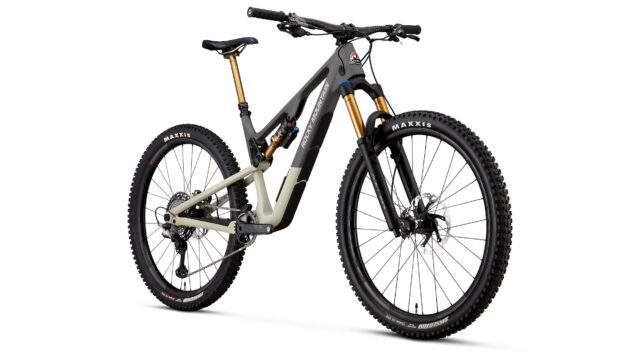
Intro
We’ve witnessed a broad spectrum in how dramatically various brands have overhauled their Trail bikes this year, from the lightly refreshed (but still excellent) Revel Rascal to the wild new high-pivot Norco Optic and Sight. Rocky Mountain is next up with their 140mm-travel Instinct, so which path have they taken?
Though the frame itself doesn’t look radically different, Rocky Mountain’s updated 2024 Instinct packs a bunch of sensible changes that emphasize geometry refinement, extensive adjustability, and size-specific suspension tunes. Let’s dig into the details to understand what Rocky Mountain was going for, and why this bike seems like an exciting evolution of the longstanding Instinct platform:
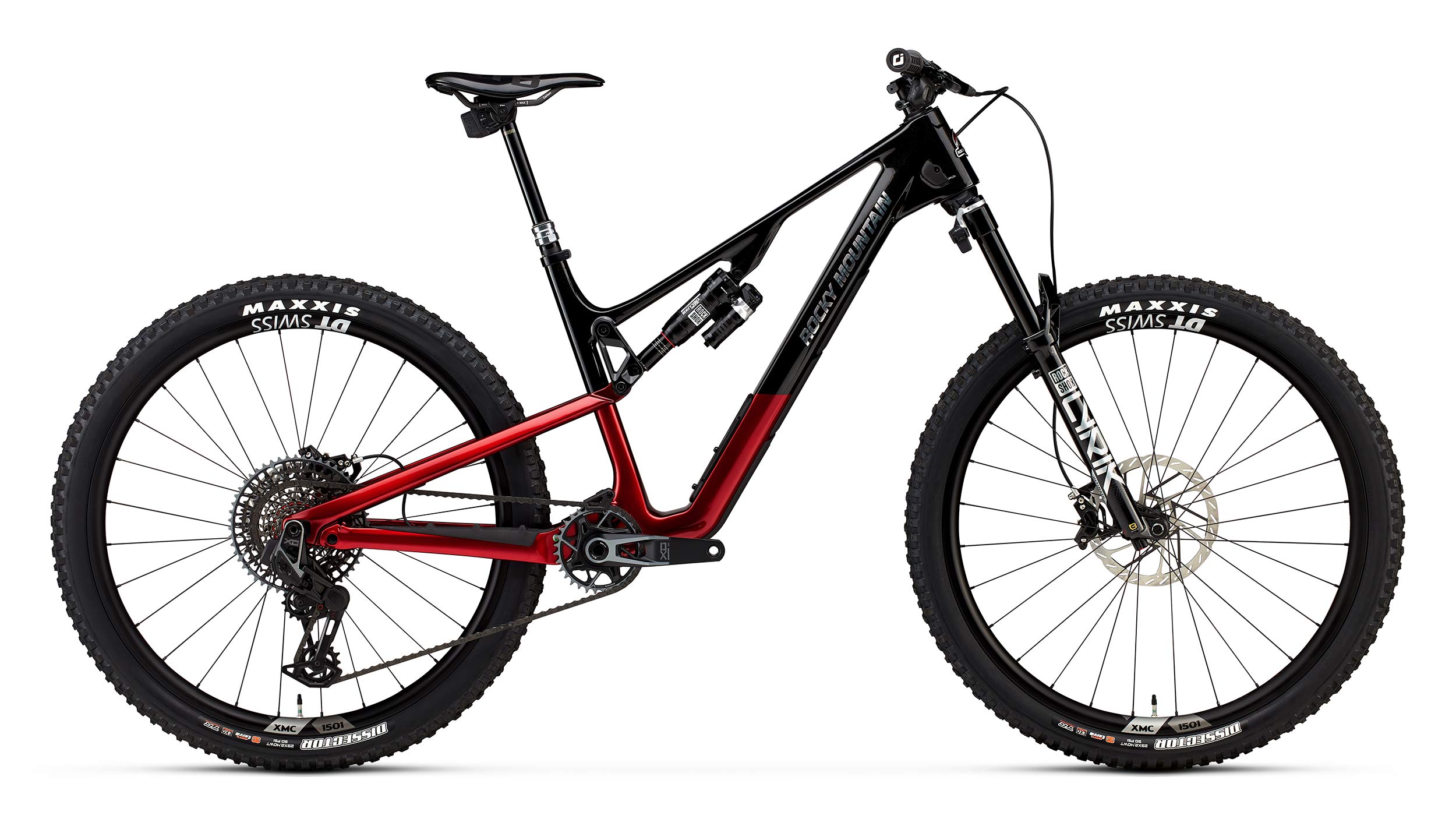
The Frame
From the short-travel Element to the Enduro-ready Altitude, Rocky Mountain’s bikes have had a very similar design language for the past several generations, and the Instinct sits well within that familiar frame silhouette. Familiar doesn’t mean boring, though, and a closer look at the frame shows some intricate shapes and angles in the frame’s tube shapes — the Instinct is undeniably a sharp-looking bike and an improvement over the outgoing version in my humble opinion. Materials-wise, Rocky Mountain still offers the Instinct in both aluminum and carbon fiber versions, with the carbon version being Rocky’s “Smoothwall” carbon and the aluminum versions getting the brand’s custom “Form” tubing.
The prior version of the Instinct shared its frame with the Altitude, the only difference being the aluminum shock mount at the top tube, but this new Instinct gets a dedicated frame without that replaceable shock mount.
Several brands have begun to dabble with high-pivot designs in shorter-travel bikes, but the Instinct sticks with Rocky’s tried-and-true interpretation of a four-bar Horst link layout. The suspension travel hasn’t changed either, with 150 mm up front and 140 mm in back, except for the top-end Instinct Carbon 99 model, which gets a 10 mm bump to 160 mm front / 150 mm rear. Rocky Mountain also says they’ve tweaked the suspension kinematics on the new bike, but the details of what has changed aren’t stated.
A lot of brands are offering size-specific chainstay lengths on a lot of bikes these days. However, and as with the prior version of the Instinct, Rocky Mountain has gone beyond many other brands by offering size-specific suspension tunes. This includes both different leverage curves and different shock tunes for each size, which will likely be particularly appealing to riders at the extreme upper and lower ends of the size range. The shock sizes stay the same as the prior Instinct, with a higher-leverage arrangement for the XS and Small sizes via a 190 x 45 mm shock; the Medium, Large, and XL sizes get a longer 210 x 52.5 mm shock.
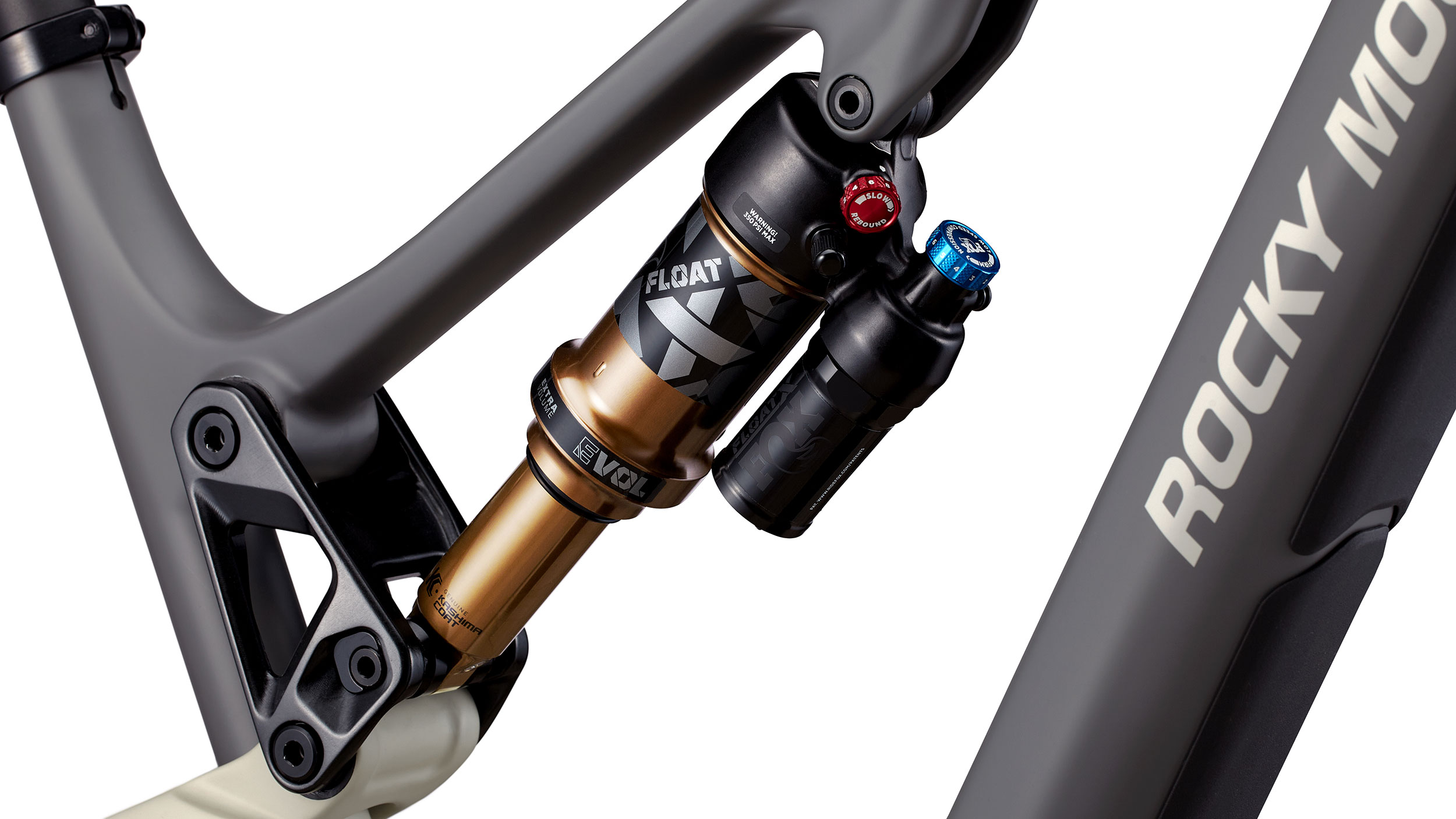
Rocky Mountain also keeps the same varied wheel sizes, with the XS frame rolling on dual 27.5” wheels, the Small being offered with either 27.5’’ or 29’’ ones (via different frame versions), and the Medium, Large, and XL sizes being dedicated 29ers. Interestingly, Rocky has opted not to follow the trend of offering mullet configurations, which is something of a surprise, especially in the smaller sizes where full 27.5” configurations are becoming an increasingly rare option.
Other details include an updated PenaltyBox 2.0 downtube storage system (on carbon models only), fully guided internal cable routing (hooray for no headset routing!), and shorter seat tube lengths across the board to allow for longer droppers. The PenaltyBox 2.0 comes with a custom tool wrap and includes a concealed compartment for AirTag or Tile trackers as an anti-theft (maybe more “pro-recovery after theft”) measure. The bottom bracket remains press fit, which is a bit of an inconvenience for home mechanics. But Rocky Mountain also still uses generous amounts of rubber frame protection on the Instinct, with a lengthy downtube protector and additional protection on the drive-side chainstay and seatstay.
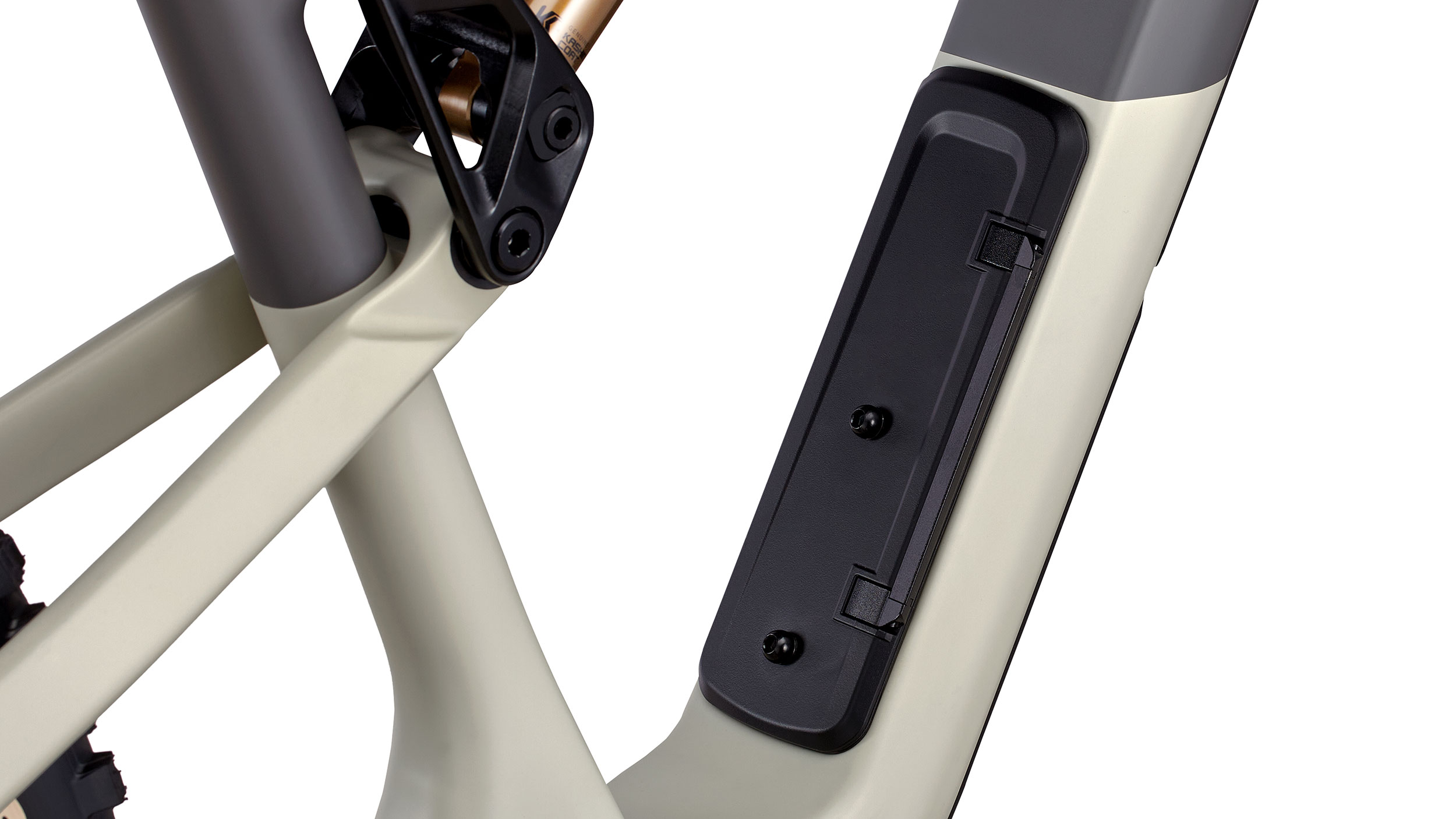
Fit & Geometry
Adjustability is still a clear priority for Rocky Mountain, but the 2024 Instinct sees some changes in that regard. The new Instinct keeps the familiar geometry adjustment at the lower shock mount, but moves from the prior iteration’s more complex RIDE-9 configuration (i.e., nine adjustment positions) to a simpler RIDE-4 implementation (four adjustment positions), while also adding +/- 5 mm of reach adjustment via a reach-adjust headset. The headset cups drop in (no tools needed to press them in or out), and the Instinct comes with a neutral set installed and separate +/- 5 mm cups in the box.
That’s still a lot to play with, but the new Instinct reduces the number of parts associated with the more on-the-fly RIDE adjustment at the shock link. That’s probably a good thing, given that the four RIDE-4 positions still offer much more adjustment than most other systems out there.
Adding to customization options, the frame also keeps the two-position axle adjustment, which offers 10 mm of chainstay adjustment, from 437 to 447 mm. While that measurement varies by ~1 mm depending on the RIDE-4 position, those lengths and adjustment ranges remain essentially the same as the prior version of the Instinct.
The wide range of adjustments means that it’s easiest to talk about geometry changes in one specific position, and we’ll use the neutral position on the RIDE-4 chips as a reference. Using a size Medium as the baseline, the new Instinct sees some nuanced changes in its geometry that can’t just be generalized as the common “longer and slacker” treatment. The headtube angle does get quite a bit slacker, going from 65.7° to 64°, while the reach shortens up a bit from 462 mm to 455 mm on the new one. That slacker head angle produces a longer bike, and the wheelbase grows by a full 18 mm over the prior version, to 1,227 mm. The effective top tube also shrinks by 10 mm, to 599 mm.
Otherwise, the changes are fairly slight. The bottom bracket drop stays the same (36 mm in the neutral position for the 29” version), and the stack is a bit higher than before, at 622 mm on the Medium. The seat tube angle gets just a bit steeper, gaining 0.3°, to 77° in the neutral position.
Overall, the Instinct keeps fairly sensible geometry figures that fit where many brands seem to be coalescing at each size. E.g., at 6’0’’ / 183 cm, the size Large Instinct’s 480 mm reach and 636 mm stack in the neutral setting are right around my normal happy place. The RIDE-4 system, reach-adjust headset, and two-position chainstays give the bike an extensive range of adjustment, but the overall story appears to be fairly minor updates, outside of that significantly slacker head angle — a change that should grant some additional poise and stability when the trail gets rough and/or steep.
The Builds
Rocky Mountain offers an impressive range of build options for the Instinct, from the Carbon 99 model that’s dripping in electronics to the budget-friendly Instinct Alloy 10. Rocky Mountain does note some regional variation in availability, so it will be interesting to see which versions are available between the US and Canada once the bikes hit shops.
Color-wise, the alloy and carbon models share the same paint job options at each level, and all colors see some very creative naming conventions. All models except the Carbon 99 are available in a muted, grey-toned “Bad to the Bone / Smokin’ In The Boys Room” colorway, whereas the Carbon 70, Carbon 50, and Alloy 50 models also get a bronze and yellow colorway dubbed “We Are the Champions / Platinum Blonde / Black Dog.” The Carbon 70 and Carbon 90 models are available only in “Bad to the Bone / Smokin’ In The Boys Room,” and the highest-end Carbon 99 model gets a very sharp red, black, and chrome paint job called “Highway to Hell / Still of the Night / Foil.”
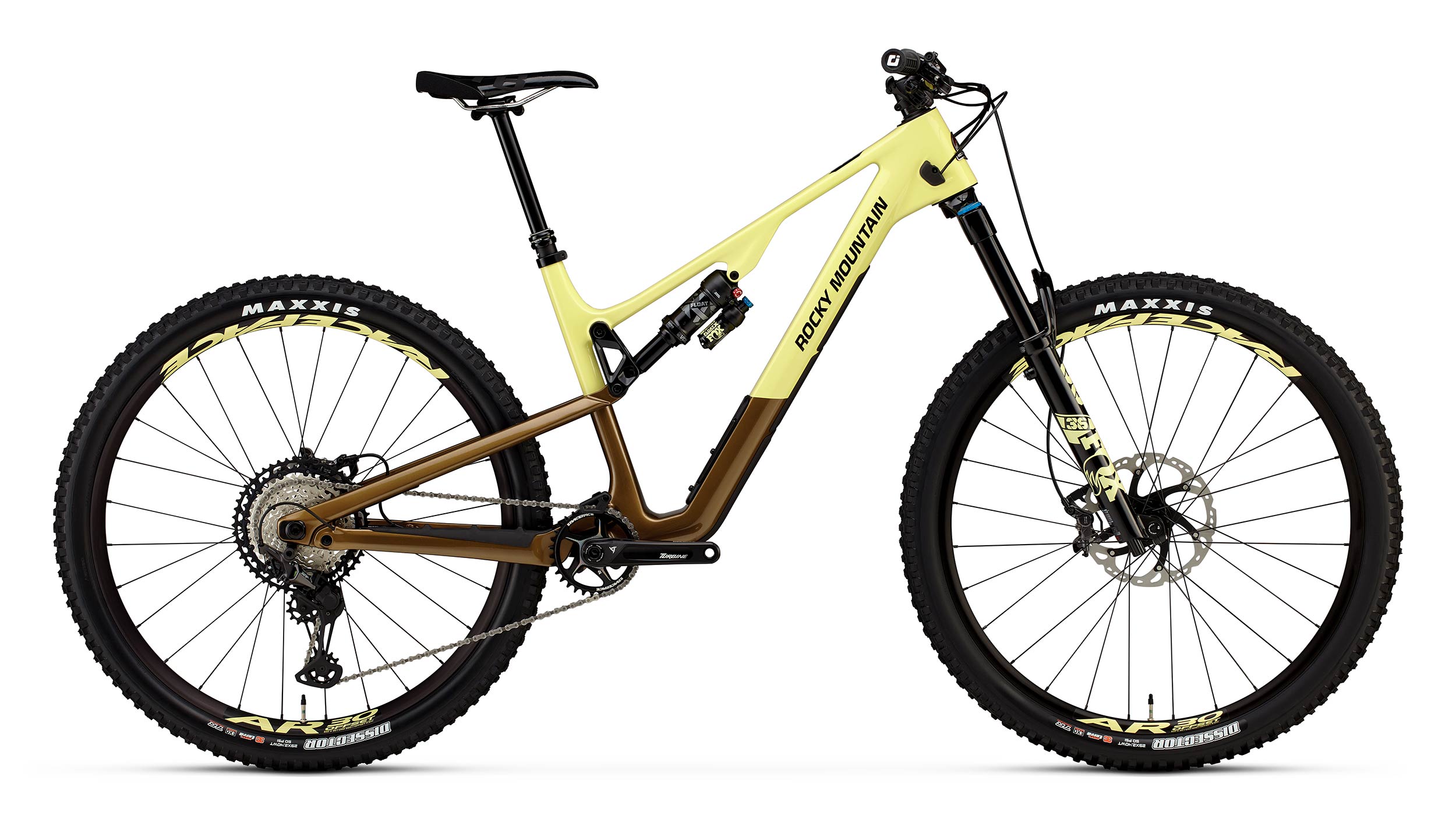
We’ve listed below some of the highlights of the builds. Note that Rocky Mountain does not differentiate between the SRAM and Shimano builds from a price perspective at the time of publishing, but we will update this article if those prices end up being different down the line. In addition to the complete builds, Rocky Mountain will also offer a carbon frameset with a Fox Float X Factory shock for $3,899 USD / $4,699 CAD, which is only available in the “Bad to the Bone / Smokin’ In The Boys Room” paint.
- Drivetrain: Shimano CUES 11spd
- Brakes: Tektro HD-M275 (w/ 180 mm rotors)
- Fork: RockShox Recon Silver RL 150 mm
- Shock: Rockshox Deluxe Select
- Wheels: Rocky Mountain TR30 rims w/ Shimano TC500 hubs
- Dropper Post: X Fusion Manic Composite (XS: 125 mm; SM: 150 mm; MD: 175 mm; LG – XL: 200 mm)
- Drivetrain: Shimano Deore 12spd
- Brakes: Shimano MT4120 (w/ 203 mm front / 180 mm rear rotors)
- Fork: RockShox 35 Gold RL 150 mm
- Shock: RockShox Deluxe Select RT
- Wheels: WTB ST i30 TCS 2.0 rims w/ Shimano TC500 hubs
- Dropper Post: (XS: 125 mm; SM: 150 mm; MD: 175 mm; LG – XL: 200 mm)
- Drivetrain: Shimano XT
- Brakes: Shimano MT6120 (w/ 203 mm front / 180 mm rear rotors)
- Fork: Fox 36 Performance (150 mm)
- Shock: Fox Float X Performance
- Wheels: WTB ST Light i30 TCS 2.0 w/ Shimano XT rear hub and Rocky Mountain SL front hub
- Dropper Post: X Fusion Manic Alloy (XS: 125 mm; SM: 150 mm; MD: 175 mm; LG – XL: 200 mm)
- Drivetrain: Shimano Deore 12spd
- Brakes: Shimano MT4120 (w/ 203 mm front / 180 mm rear rotors)
- Fork: Marzocchi Z2 (150 mm)
- Shock: Fox Float DPS Performance
- Wheels: WTB ST i30 TCS 2.0 rims w/ Shimano TC500 hubs
- Dropper Post: X Fusion Manic Composite (XS: 125 mm; SM: 150 mm; MD: 175 mm; LG – XL: 200 mm)
- Drivetrain: Shimano XT
- Brakes: Shimano MT6120(w/ 203 mm front / 180 mm rear rotors)
- Fork: RockShox Lyrik Select RC (150 mm)
- Shock: Fox Float X Performance
- Wheels: WTB ST Light i30 TCS 2.0 rims w/ DT Swiss 370 Star-Ratchet rear hub and Rocky Mountain SL front hub
- Dropper Post: X Fusion Manic Alloy (XS: 125 mm; SM: 150 mm; MD: 175 mm; LG – XL: 200 mm)
- Drivetrain: Shimano XT
- Brakes: Shimano XT Trail, metal pads (w/ 203 mm front / 180 mm rear rotors)
- Fork: Fox 36 Performance Elite Grip2 (150 mm)
- Shock: Fox Float X Performance Elite
- Wheels: Race Face AR 30 rims w/ DT Swiss 370 Star-Ratchet rear hub and Rocky Mountain SL front hub
- Dropper Post: Race Face Turbine R (XS: 125 mm; SM: 150 mm; MD: 175 mm; LG – XL: 200 mm)
- Drivetrain: SRAM GX Transmission
- Brakes: SRAM G2 RSC (w/ 200 mm front / 180 mm rear rotors)
- Fork: RockShox Lyrik Select+ 150 mm
- Shock: RockShox Super Deluxe Ultimate
- Wheels: Rocky Mountain 30AM Carbon rims w/ DT Swiss 370 Star-Ratchet rear hub and Rocky Mountain SL front hub
- Dropper Post: OneUp (XS: 125 mm; SM: 150 mm; MD: 180 mm; LG – XL: 210 mm)
- Drivetrain: Shimano XTR
- Brakes: Shimano XTR Trail (w/ 203 mm front / 180 mm rear rotors)
- Fork: Fox 36 Float Factory Grip2 (150 mm)
- Shock: Fox Float X Factory
- Wheels: Race Face ARC Carbon 31 rims w/ DT Swiss 350 hubs
- Dropper Post: Fox Transfer Factory (XS: 125 mm; SM: 150 mm; MD: 175 mm; LG – XL: 200 mm)
- Drivetrain: SRAM X0 Transmission
- Brakes: SRAM Code RSC (w/ 200 mm front / 180 mm rear rotors)
- Fork: RockShox Lyrik Ultimate Flight Attendant (160 mm)
- Shock: RockShox Super Deluxe Ultimate Flight Attendant
- Wheels: DT Swiss XMC 1501 Carbon
- Dropper Post: RockShox Reverb AXS (XS: 125 mm; SM: 150 mm; MD – XL: 170 mm)
FULL REVIEW
The prior-generation Rocky Mountain Instinct shared its frame (albeit with a different shock mount and shorter-stroke shock) with the now-prior-gen Altitude, Rocky Mountain’s Enduro race bike. But the Altitude recently got a major overhaul and a completely different design from the old bike, and Rocky Mountain gave the new Instinct its own dedicated frame.
So, did they take it in a different direction, or stay true to the versatile, do-it-all nature of the prior-gen bike? We’ve spent the last several months on the new Instinct to find out.
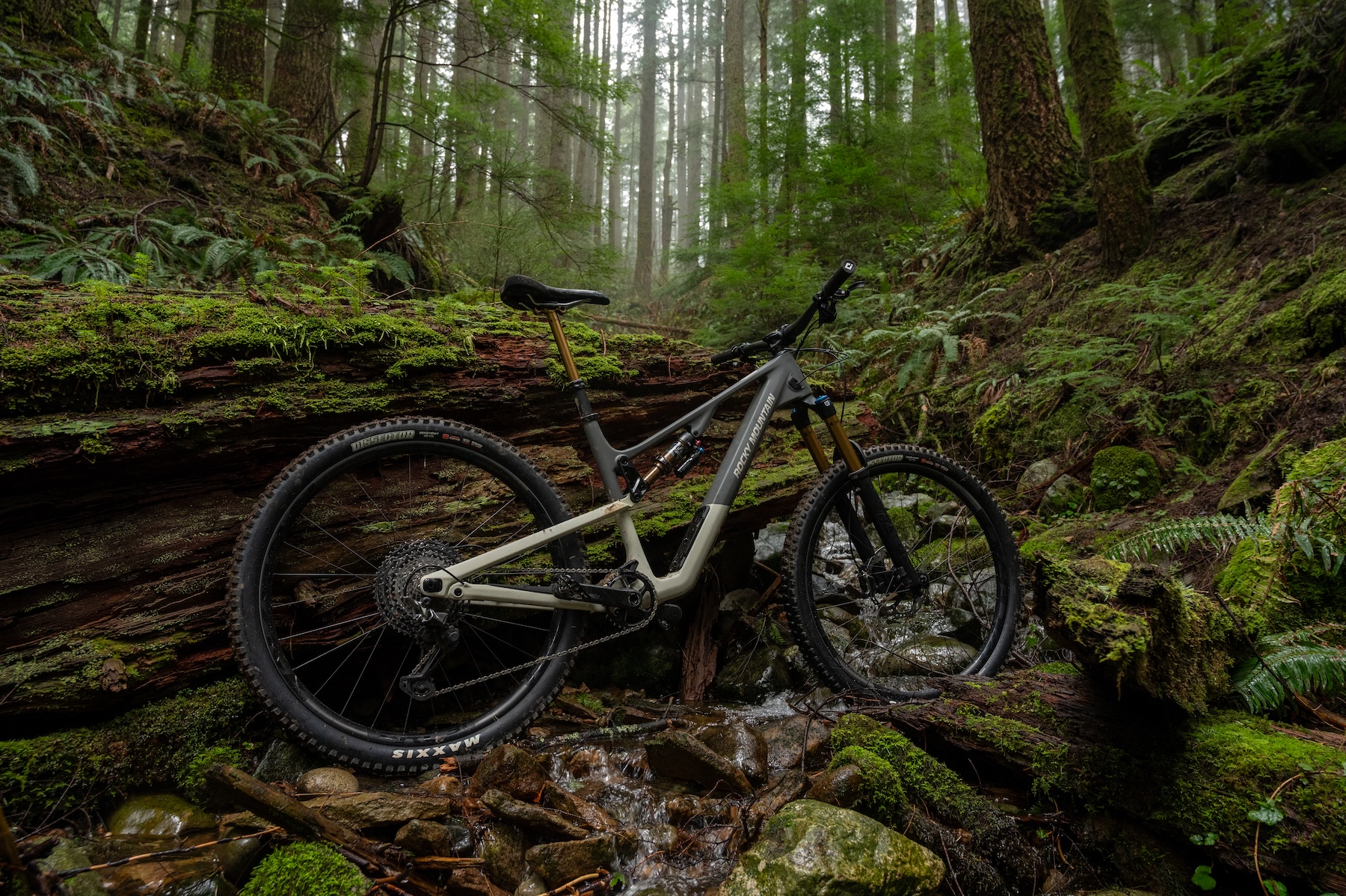
Fit & Sizing
David Golay (6’, 170 lb / 183 cm, 77.1 kg): Rocky Mountain’s recommended sizing chart for the Instinct puts me comfortably in the sizing band for the Large frame and at the very bottom of the range for the XL, but I wasn’t tempted to size up from our size Large review bike. I probably could fit on the XL if I really wanted to — and I think Rocky Mountain’s sizing guidelines seem perfectly reasonable. But, given what the Instinct does best and the kinds of terrain it shines in most (more on that in a minute), it’s not a bike that made me want to size up and chase an especially roomy fit.
That said, I did prefer to run the Instinct in its longer headset position to stretch things out just a little bit over the neutral headset cups that come installed (they’re a drop-in design, so swapping them is easy). The +/- 5 mm reach adjustment that those cups offer makes a subtle but appreciable difference in the fit of the Instinct, and they stayed quiet and didn’t give me any trouble during my time with the bike.
If I have any complaints about the fit of the Large Instinct, it’s that I’d like to see Rocky Mountain leave the fork’s steerer tube a bit longer to leave more room to tinker with bar height. Our review bike showed up with just 10 mm of stem spacers, and I wanted the bar a touch higher than I could get out of that setup. I’m not really calling for the Instinct to have a higher stack height, since it’s not especially short at about 627 mm (depending slightly on the geometry setting chosen). Swapping in a 30mm-rise bar did the trick, but it’d be nice to have been able to get there just by moving stem spacers rather than swapping parts entirely.
That minor gripe aside, though, I found the fit of the Large Instinct to work well for me and feel nicely in keeping with modern norms for a do-it-all Trail bike. There’s nothing quirky or otherwise all that out of the ordinary going on here, in a good way.
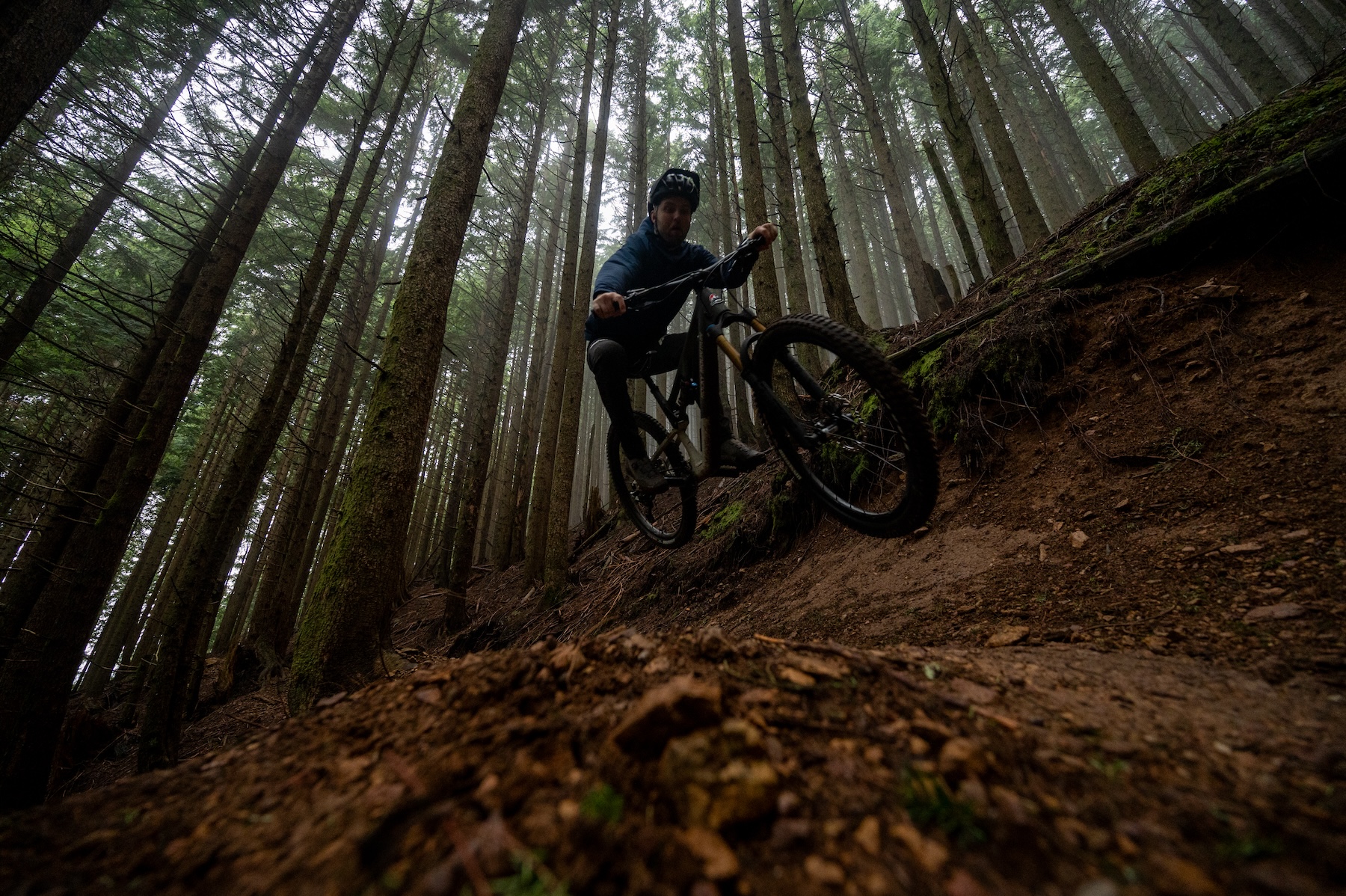
Simon Stewart (6’, 170 lbs / 183 cm, 77.1 kg): David and I are the same height and weight, but we have different preferences regarding fit and geometry. For instance, he favors longer reaches and longer chainstays, whereas I like a more compact fit and shorter chainstays. In that regard, the Instinct in a size Large is quite possibly the perfect bike for us both to review — with reach adjustment, Ride-4 geometry adjustment, and a 10 mm range of chainstay adjustment, it can easily accommodate both of our fit and riding style preferences.
Even without the headset cups, the Instinct’s reach changes a fair bit depending on which of its Ride-4 positions you’re using. I started in the slackest setting, and at 474 mm (size Large, neutral headset position), it’s on the short side for me. So like David, I opted for the +5 mm headset position to bring it out to 479 mm, which feels noticeably better. I did eventually land on the neutral Ride-4 position as my favorite (more on why later); with the + 5 mm headset, that puts the reach at 485 mm. For me, 485 mm is on the long end of my preference, but it actually feels just right on the Instinct — interestingly, while David and I often differ on reach preference, we ended up in the same place on the adjustable Instinct.
I’m a big proponent of taller stack heights (although that mostly applies to eMTBs), and agree with David that it would be helpful if Rocky Mountain left the steerer longer to allow for more than 10 mm of spacers under the stem, given that the Instinct’s stack height is a tad on the low side. With that said, I strangely found the bar height to work well for me and didn’t need to swap in a higher-rise handlebar as David did.
When adjusting the fit and geometry of the Instinct, I couldn’t help but think about how nice it would be for someone purchasing direct-to-consumer, where you don’t have the opportunity to test ride. I think the Instinct presents a high probability of dialing in the fit without having to exchange parts, or bikes for that matter.
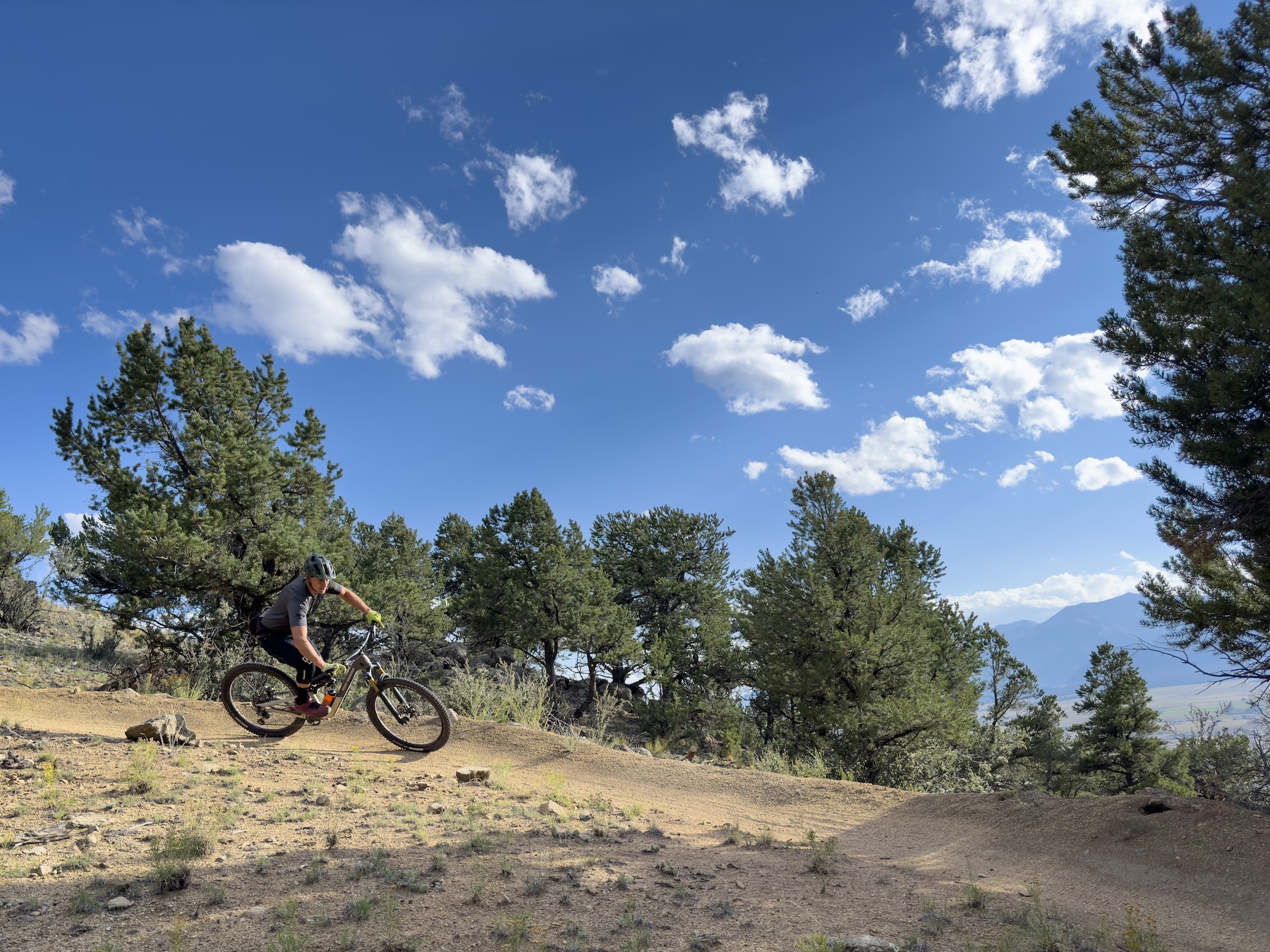
Climbing
David: I really like the way the Instinct climbs, and it specifically stands out for being notably efficient, but it does so without feeling like it’s totally giving up on traction and small-bump sensitivity. The Instinct’s pedaling performance is definitely biased a bit toward efficiency over maximum compliance — traits that tend to be in direct conflict with each other — but it’s still reasonably well-rounded overall.
There are a lot of bikes — even considerably longer-travel ones — that feel pretty efficient if you’re grinding your way up a climb at a relatively steady cadence. That holds true of the Instinct, but it also stands out for feeling snappy and efficient when you’re pushing the pace harder and putting down a choppier pedal stroke. The relatively low weight (and light wheels / fast-rolling tires) on our C90 Shimano review build don’t hurt, but the Instinct’s suspension performance deserves a good bit of credit there.
(Our review bike weighs 29.61 lb / 13.43 kg without pedals, and came with Maxxis Dissector Exo MaxxTerra tires / Race Face ARC 31 rims on DT Swiss 350 hubs, for the record.)
The Instinct’s pedaling position is also quite good. The seat tube is steep enough to make it easy to keep the front wheel planted even on very steep fire road climbs, but it’s dialed back just enough to still feel comfortable pedaling on flat ground and make coming out of the saddle for a big standing effort feel smoother than it tends to on bikes with ultra-steep seat tubes.
There’s a little variation depending on the wide range of geometry settings the Instinct offers, and combining the slackest Ride-4 settings with the short chainstay option does make the Instinct a bit more wheelie-prone on really steep climbs, but the overall adjustment window feels quite sensible.
There are definitely bikes that better cater to folks who specifically want a really cushy, grippy-feeling ride on the way up (check out our Deep Dive comparisons for a lot more on that) but the Instinct does pretty well there for how well it puts down power. Conversely, there are also plenty of (mostly shorter-travel) bikes that are even more efficient, but for a 140mm-travel Trail bike, the Instinct does quite well in that regard.
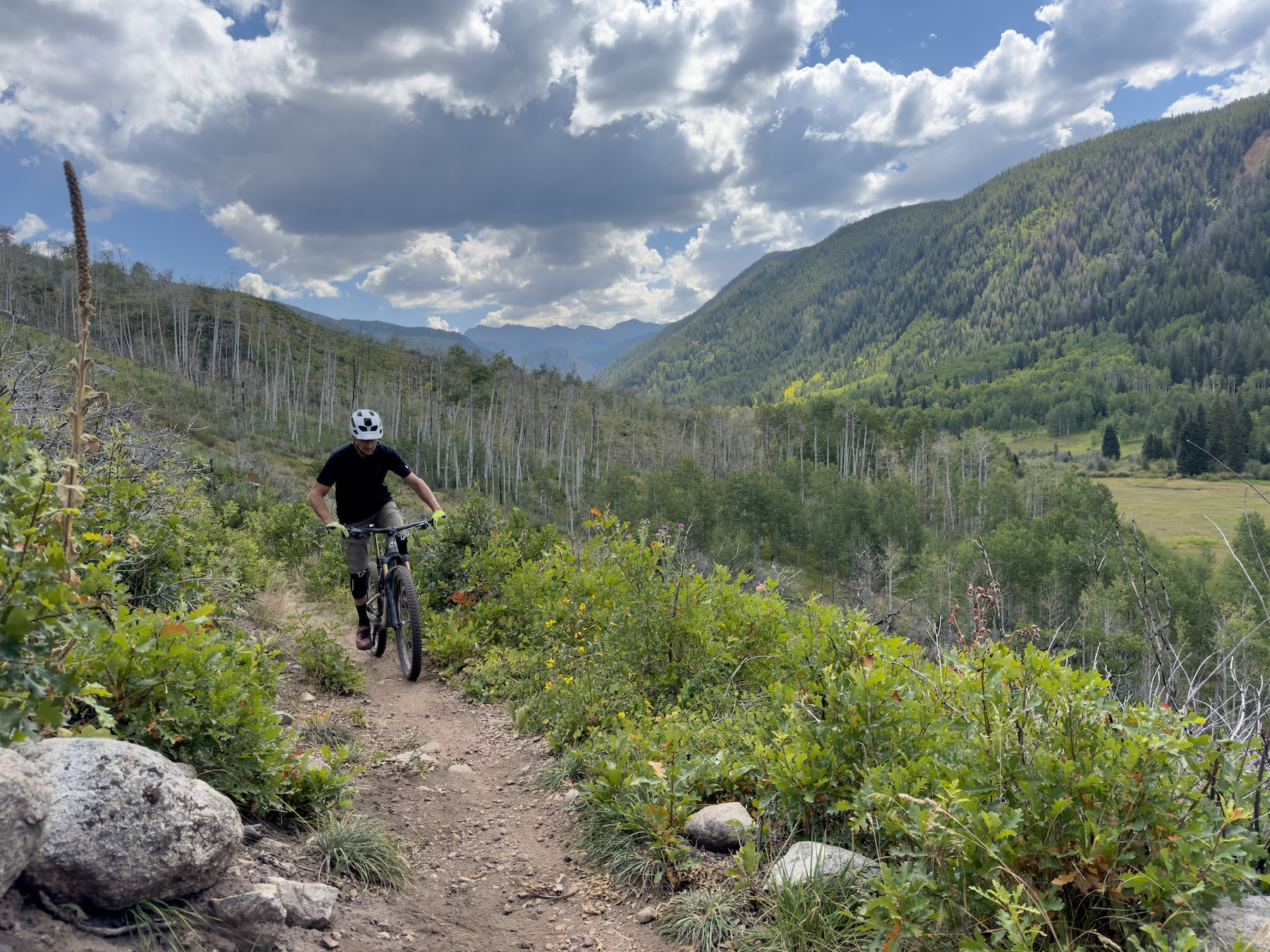
Simon: I’m with David here — I love how the Instinct climbs. I’ve recently been spending a good bit of time on some exceptional climbing bikes, including the Yeti ASR and Cannondale Scalpel, so my climbing bar is fairly high at the moment, and yet the Instinct still impresses me.
Like David, I found the low weight (29.61 lb / 13.43 kg) noticeable, while the Instinct’s efficient suspension and comfortable seated climbing position work in concert to make it one of the quicker-climbing Trail bikes I’ve been on.
The Ride-4 system made it possible to dial in the geometry to best suit the terrain in my area. There are endless long climbs where I live, many of which are also rocky, so I settled on the neutral Ride-4 position (aka, “position 3”) as my preference — that put the seat tube angle at 77º, and the bottom bracket drop at 36 mm. I found the steeper seat tube angle and increased crank clearance (over Ride-4 settings 1 & 2) to make the most difference while climbing. On paper, the .5º steeper seat tube angle going from the slackest position (“position 1”) to the neutral position doesn’t look like much, but it makes a big difference on super steep sections of trail, allowing me to stay centered on the saddle instead of a pronounced forward shift.
When experimenting with the Instinct’s chainstay lengths, I preferred them in the short setting (437 mm) for climbing, which I think improves on the already stellar rear-wheel traction (more on that below), while also making the front end feel lighter when lifting up onto squared-off ledges. David typically goes for longer chainstays than I do, so I wasn’t surprised to find the Instinct set on the longer position when I got it from him. I rode it in that position for quite a few miles before changing, and while I didn’t have a strong preference when descending, the shorter position won me over when climbing.
With its climbing geometry dialed into my preferences, the Instinct is an inspiring climber. I made quite a few technical moves that are typically low-percentage maneuvers for me (<50%) on the first try aboard the Instinct. I think a lot of that had to do with the excellent traction I was getting out of the rear end, despite its efficient-feeling platform under power. Over and over again, I was surprised by how well the Instinct gripped in loose, honestly, pretty terrible conditions. There’s often a moment while tackling tricky climbing moves when you have to stay committed, and the Instinct’s ability to put the power down gave me the confidence to routinely go for it in those instances.
Descending
David: There’s a pretty big spectrum within the category of ~140mm-travel Trail bikes, from relatively quick-handling options that feel best suited to covering lots of miles to much more descending-oriented mini-Enduro sleds. The Instinct occupies an interesting — and fairly broad, given how adjustable and adaptable it is — slice in the middle of that range.

At the long / low / slack end of its geometry settings (i.e., Ride-4 chip in the slackest setting and the chainstay chip in the long one), the Instinct still feels sharper handling and more agile than its (fairly radical) geometry numbers might suggest. A 63.5° headtube angle and 450 mm chainstays wouldn’t be the least bit out of place on a modern Enduro bike with 30 mm more travel at both ends, and the Instinct’s 44 mm bottom bracket drop in that configuration is very notably low. But even at that end of the geometry settings, the Instinct feels quicker handling and not as emphatically stable to the exclusion of all else as I would have expected.
To be clear, I’m not complaining. The Instinct is relatively, but not over-the-top stable by the standards of ~140mm-travel Trail bikes, while also being notably lively and energetic in terms of its suspension performance. That’s a ton of fun on the right trails — particularly ones that are relatively fast, but not wildly steep or rough (when a bigger, longer-travel bike would feel appropriate). And, of course, moderating the Instinct’s ample geometry adjustments only makes it quicker handling, particularly at more moderate speeds / in tighter spots.
I think the Instinct’s comparatively supportive, lively-feeling suspension is a big part of the reason it feels so nimble and easy to move around, even at the long / low / slack end of its geometry range. It’s an especially easy bike to boost off stuff and throw around, while still having enough stability and suspension compliance to feel like there’s a solid cushion to make up for some mistakes and not require that you ride with the utmost precision. Taking that approach requires a bit of speed and aggression, but it’s incredibly rewarding if you get it right, and the Instinct facilitates it very well.
The Instinct can also be a much more conventional-feeling sort of efficient, energetic Trail bike, especially if you dial back its geometry settings a bit. Steepening the headtube and raising the bottom bracket makes the Instinct less demanding of being ridden aggressively, and especially if you also soften the suspension up a bit, it can be pretty easygoing and fun on mellow trails at more moderate speeds.

The huge range of geometry adjustability makes it hard to ascribe any one particular preferred body position to the Instinct. Depending on the chosen ratio of front- to rear-center length, its preferred body position / weight bias can vary from being pretty neutral (steeper headtube / longer chainstays) to having a distinct preference for being ridden with a bunch of weight over the front end (slack headtube / short chainstays).
For true all-rounder Trail bike duty, I generally prefer the Instinct with the longer chainstay setting and in the middle of the Ride-4 settings (usually position 3). But Rocky Mountain has done an impressive job of baking in an especially wide range of geometry adjustments that still feel coherent across most of the range. It’s probably the case that folks on the smaller frame sizes will favor the shorter chainstay settings a bit more and vice versa (the Instinct uses that two-position chainstay flip chip in lieu of size-specific chainstays). But this approach leaves a lot of room for folks to tinker and dial things into their preferences, whatever those may be.
Simon: My first descents on the Instinct were with the Ride-4 in position 1 (slackest), and the chainstays in the long setting (447 mm). In those settings, the head angle is a progressive 63.5º — which up until recently would have been wildly slack. These settings, combined with the +5 mm headset cups, result in the Instinct having plenty of real estate between the wheels (a >1259 mm wheelbase, size Large). Due to its long wheelbase and slack head angle, I was expecting the Instinct to land on the more stable, slower-handling end of the spectrum; while it is stable, its handling is not slow and ponderous. As David also found, the Instinct is still surprisingly agile and poppy, and I would agree that much of that credit has to go to the lively-feeling suspension. Even in high-speed chunk, where its geometry-derived stability allows me to ratchet up the speed, it takes me going a lot faster than expected to start to feel the limit of what the Instinct’s 140 mm of rear suspension can manage.
Interestingly, after all of the geometry adjusting I did, the recurring theme for me is that I found the relatively narrow head angle range (63.5º – 64.3º) to have the least impact on where I ultimately positioned the geometry. Like David, I settled on the Ride-4 chip’s “position 3” as my preference, mainly because I like a steeper seat tube angle (when climbing; it has little effect while descending due to dropper seatposts) and more crank clearance. Honestly, I would be happy with any of the head angles offered by the Ride-4 system. But I think the 64º head angle in the neutral position feels appropriately matched to the Instinct’s lively feeling suspension and agile handling characteristics.

As I noted above, I preferred the shorter chainstay position when climbing. When descending, my preference was more trail-dependent. Not surprisingly, I like the added stability and more neutral body position of the long chainstay setting when riding steep, fast, chunky descents. On smoother trails with tight corners and generally more flow, I enjoy the Instinct in the short chainstay position because it feels more playful and easier to throw around.
One of the attributes of the Instinct’s energetic and lively suspension that was very noticeable is the bike’s ability to generate speed when pumping through rollers and exiting corners — if I were to compete in a dual slalom race, the Instinct would be on my shortlist.
Overall, the Instinct’s adjustability offers riders the opportunity to easily tailor its descending focus to preferences and/or trail conditions, further amplifying its do-it-all Trail bike chops.
David: Apart from wishing that Rocky Mountain had left the steerer tube on the Fox 36 Factory fork a bit longer, as I mentioned earlier, the build on our high-end C90 Shimano review bike (MSRP: $8,900) left little to be desired.
This build’s Shimano XTR drivetrain is still excellent, and it’s a nice reminder of how good mechanical drivetrains can be, amidst all the SRAM Transmission bikes we’ve had come through of late. I’m glad to see a 200 mm dropper post come stock, and the other details were similarly well-considered. I did swap in a Maxxis Minion DHR II MaxxGrip front tire in place of the MaxxTerra Dissector for most of my time with the Instinct, which mostly fell in the wetter spring months around here, but that’s an easy swap.
All that said, I’d probably call the Instinct C70 Shimano the best bang-for-buck build of the bunch. For $2,500 less than the C90 Shimano we tested, you step down to Fox Performance-Elite-tier suspension from the Factory versions (which doesn’t make much difference), a Shimano XT drivetrain and brakes from XTR, and lose the carbon wheels and cranks of the C90. Rocky Mountain says that adds about a pound over the C90, but the performance difference should be fairly modest otherwise.

Simon: The standout component here for me is the Shimano XTR drivetrain — David and I both enjoyed the change after recently having spent more time on SRAM Transmission-equipped bikes. Shimano XTR shifts beautifully (and faster than SRAM’s Transmission…), plus it was nice to not think about batteries at all for the first time in what seems like forever (I test lots of eMTBs as well, so batteries are a constant consideration). The only thing I would change — and I admit it is entirely vain — would be the Race Face Next SL cranks. I think XTR cranks would have really tied the room together.
I rode the Instinct in mostly dry conditions here in Colorado and found the tire spec to be spot on. Maxxis Dissectors have become one of my favorite tire choices for Trail bikes like the Instinct, due to their lighter weight and faster-rolling ride (over Maxxis Minion DHR II / DHF), while still offering solid traction.
I agree with David that the C70 Shimano build offers what looks like the best value. The $2500 delta between it and our C90 Shimano is nothing to sneeze at, and the spec will most likely have very little effect on performance. That said, I certainly enjoyed the XTR parts.
Who’s It For?
David: The Rocky Mountain Instinct is an excellent mid-travel, do-it-all Trail bike for folks who’d prefer something that’s a little on the more lively, energetic, sharp-handling end of the spectrum for that class, but that’s still stable and composed enough to handle some fairly burly trails — especially at the longer / slacker end of its ample geometry adjustment range.
But mostly, the Instinct is a notably efficient-pedaling, energetic-feeling, do-it-all Trail bike, and it’s a particularly versatile option for folks with the right preferences.
Simon: I agree with David here, and will add that the Instinct did especially well on the high-elevation trails I rode it on in Colorado. Its low weight and comfortable seated climbing position, in combination with the efficient pedaling suspension, was very noticeable on long mountainous slogs. That combo allowed me to get to the top with more energy in reserve to take advantage of what I think is one of the better-descending bikes in this travel category.
With such a wide range of geometry adjustments, I think the Instinct is particularly appealing for folks after a one-bike quiver. Set it long and slack for rowdy trails or days at the bike park, short and slack for poppy flowy trails, and short and neutral for everything else (for me, anyway). Throw in the adjustable reach, and I’d say it would be hard not to find a permutation of the Instinct to suit most riders.
Bottom Line
The latest iteration of the Rocky Mountain Instinct is an especially good take on a relatively lively, do-it-all Trail bike — but it’s also highly adaptable and can be set up to cater to an impressively wide range of desired traits, given its ample geometry adjustments.
Despite being able to be set up notably long and slack for its class, the Instinct feels more like a versatile all-rounder than some mini-Enduro sled, but it’s very, very good at what it does.
Deep Dive Comparisons
BLISTER+ members and those who purchase our Digital Access Pass can check out our Deep Dive comparisons linked below. Get our Digital Access Pass to view all our Deep Dives and Flash Reviews, or become a BLISTER+ member today to get access to that and a LOT more, including the best worldwide Outdoor Injury Insurance, exclusive deals and discounts on skis, personalized gear recommendations from us, and much more.

Deep Dive: 2024 Rocky Mountain Instinct
We compare the Rocky Mountain Instinct to the Orbea Occam LT, Trek Fuel EX, Transition Smuggler, Revel Rascal V2, SCOR 2030, Norco Optic, Norco Sight, Santa Cruz Hightower 3, Yeti SB135, Spot Mayhem 140, Forbidden Druid V2, REEB Steezl, and Deviate Highlander II.
Blister’s Flash Reviews and Deep Dives are accessible to those who purchase one of our paid subscriptions
To get our comprehensive Deep Dives and our initial, unfiltered reports on new gear, become a member and receive many other services, deals, and discounts.
If you’re already an active member, please log in.
(If you’re already logged in and a member in good standing and seeing this message in error, please refresh this page in your browser.)


Any comments on ideal sag or what sag was set to for testing?
Patrick I’ve been on this bike all year and quickly learned that it needs 22-25% sag (with a Fox Float X that I put on it). This is KEY to the setup. I love the bike everywhere – but sag is critical.